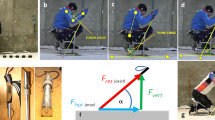Abstract
In ice hockey, players produce high velocities by skating and game actions are typically characterized by sudden accelerations and brisk decelerations. Thus, the vestibular system is particularly stressed. The aims of this study were to evaluate sensorial organization and head stabilization control of ice hockey players in order to investigate if this kind of activity induces specific sensorimotor adaptation. We studied 8 elite hockey players, 8 amateur players and 10 healthy controls. Three tests were performed: (1) sensory organization test (SOT) to evaluate sensorial organization in maintaining steady stance in quiet standing; (2) head stabilization stance test (H-STAN) to evaluate head-to-trunk stabilization during quiet steady stance; and (3) stepping test (STEP) to evaluate skills in maintaining the head stable with respect to the trunk during walking in place. In SOT, elite players had a greather visual component and reduced vestibular component. In H-STAN test, elites, when standing on foam, presented head less stable than trunk. In STEP test, with respect to normal subjects and amateurs the head of elites was less stable in the sagittal plane with eyes open and more stable in the frontal plane with eyes closed.
Similar content being viewed by others
Explore related subjects
Discover the latest articles and news from researchers in related subjects, suggested using machine learning.References
Ledebt A, Wiener-Vacher S (1996) Head coordination in the sagittal plane in toddlers during walking: preliminary results. Brain Res Bull 40(5–6):371–373
Massion J (1998) Postural control systems in developmental perspective. Neurosc Biobehav Rev 22(4):465–472
Norrè ME (1990) Posture in otoneurology. Acta Otorhinolaryngol Belg 44(2–3):55–181
Massion J (1992) Movement, posture and equilibrium: interaction and coordination. Progr Neurobiol 38:35–56
Bronstein AM, Brandt T, Woollacott MH (eds) (1996) Clinical disorders of balance, posture and gait. Arnold, London
Nashner L (1994) Evaluation of postural stability, movement, and control. In: Hasson SM (ed) Clinical exercise physiology. Mosby, St. Louis, pp 67–85
McCollum G, Shupert CL, Nashner LM (1996) Organizing sensory information for postural control in alterated sensory environments. J Theor Biol 180(3):257–270
Norrè ME (1993) Sensory interaction testing in platform posturography. J Laryngol Otol 107(6):496–501
Shumway-Cook A, Mccollum G (1991) Assessment and treatment of balance deficits in the neurologic patient. In: Montgomery P, Connelly B (eds) Motor control. Theoretical framework and practical application to physical therapy. Chattanooga, pp 123–138
Nashner LM, Shupert CL, Horak FB, Black FO (1989) Organization of posture controls: an analysis of sensory and mechanical constraints. Prog Brain Res 80:411–418
Norrè ME (1996) Head stabilization in peripheral vestibular syndromes. Clin Otolaryngol Allied Sci 21(2):151–157
Nashner LM, Shupert CL, Horak FB (1998) Head-trunk movement coordination in standing posture. Prog Brain Res 76:243–251
Allum JH, Carpenter MG (2005) A speedy solution for balance and gait analysis: angular velocity measured at the centre of body mass. Curr Opin Neurol 18(1):15–21
Pompeiano O (2006) The vestibulo-ocular and the vestibulospinal reflexes: noradrenergic influences on the plastic changes which affect the cerebellar cortex during vestibular adaptation. Arch Ital Biol 144(3–4):197–253
Wang RF, Spelke ES (2000) Updating egocentric representations in human navigation. Cognition 15(77):215–250
Crane BT, Demer JL (1997) Human gaze stabilization during natural activities: translation, rotation, magnification, and target distance effects. J Neurophysiol 78:2129–2144
Hynes LM, Dickey JP (2006) Is there a relationship between whiplash-associated disorders and concussion in hockey? A preliminary study. Brain Inj 20(2):179–188
Tegner Y, Lorentzon R (1996) Concussion among Swedish elite ice hockey players. Br J Sports Med 30(3):251–255
Nadeau S, Amblard B, Mesure S, Bourbonnais D (2003) Head and trunk stabilization strategies during forward and backward walking in healthy adults. Gait Posture 18(3):134–142
Manzoni D, Andre P, Pompeiano O (2004) Proprioceptive neck influences modify the information about tilt direction coded by the cerebellar anterior vermis. Acta Otolaryngol 124(4):475–480
Pozzo T, Berthoz A, Lefort L (1990) Head stabilization during various locomotor tasks in humans. I Normal subjects. Exp Brain Res 82:97–106
Capozzo AV (1981) Analysis of the linear displacements of the head and trunk during walking at different speeds. J Biomech 16:411–425
Cromwell RL (2004) Movement strategies for head stabilization during incline walking. Gait Posture 17(3):246–253
Guitton D, Kearney RE, Wereley N, Peterson BW (1986) Visual, vestibular and voluntary contributions to human head stabilization. Exp Brain Res 64:59–69
Cromwell RL, Pidcoe PE, Griffin LA et al (2004). Adaptations in horizontal head stabilization in response to altered vision and gaze during natural walking. J Vestib Res 14(5):367–373
Keshner EA, Hain TC, Chen KJ (1999) Predicting control mechanisms for human head stabilization by altering the passive mechanics. J Vestib Res 9(6):423–434
Keshner FA, Peterson BW (1995) Mechanisms controlling human head stabilization. I. Head-neck dynamics during random rotations in the horizontal plane. J Neurophysiol 73(6):2293–2301
Keshner EA, Cromwell RL, Peterson BW (1995) Mechanisms controlling human head stabilization. II. Head-neck characteristics during random rotations in the vertical plane. J Neurophysiol 73:2302–2312
Alpini D, Ciavarro GL, Zinnato et al (2005) Evaluation of head-to-trunk control in whiplash patients using digital cranio-corpography during a stepping test. Gait Posture 22(4):308–316
Author information
Authors and Affiliations
Corresponding author
Rights and permissions
About this article
Cite this article
Alpini, D., Hahn, A. & Riva, D. Static and dynamic postural control adaptations induced by playing ice hockey. Sport Sci Health 2, 85–92 (2008). https://doi.org/10.1007/s11332-008-0045-7
Received:
Accepted:
Published:
Issue Date:
DOI: https://doi.org/10.1007/s11332-008-0045-7




